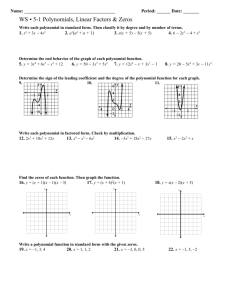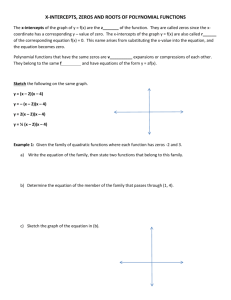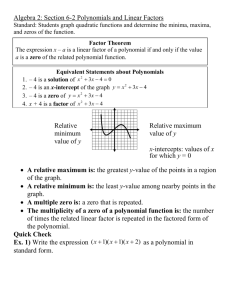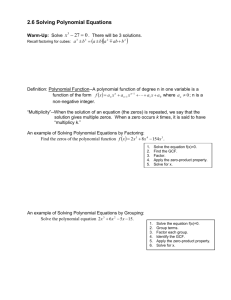Section 2.2, 2.3, and 2.5 Quiz REVIEW 2014
advertisement
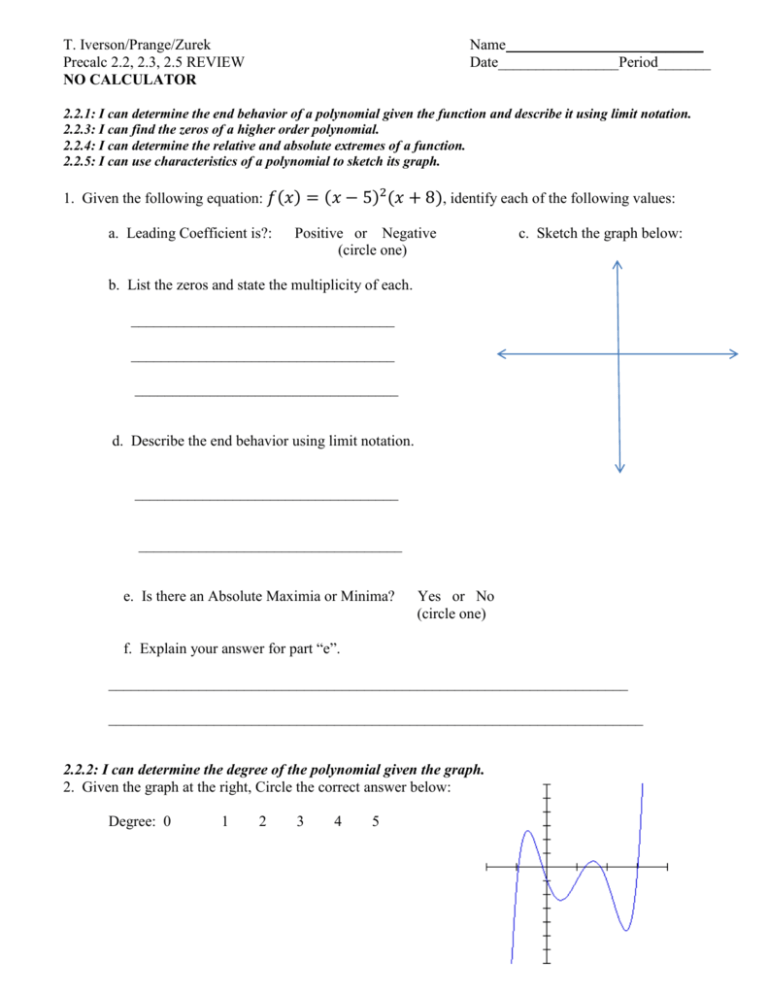
T. Iverson/Prange/Zurek Precalc 2.2, 2.3, 2.5 REVIEW NO CALCULATOR Name _______ Date________________Period_______ 2.2.1: I can determine the end behavior of a polynomial given the function and describe it using limit notation. 2.2.3: I can find the zeros of a higher order polynomial. 2.2.4: I can determine the relative and absolute extremes of a function. 2.2.5: I can use characteristics of a polynomial to sketch its graph. 1. Given the following equation: 𝑓(𝑥) = (𝑥 − 5)2 (𝑥 + 8), identify each of the following values: a. Leading Coefficient is?: Positive or Negative (circle one) c. Sketch the graph below: b. List the zeros and state the multiplicity of each. ___________________________________ ___________________________________ ___________________________________ d. Describe the end behavior using limit notation. ___________________________________ ___________________________________ e. Is there an Absolute Maximia or Minima? Yes or No (circle one) f. Explain your answer for part “e”. _____________________________________________________________________ _______________________________________________________________________ 2.2.2: I can determine the degree of the polynomial given the graph. 2. Given the graph at the right, Circle the correct answer below: Degree: 0 1 2 3 4 5 2.3.1: I can use synthetic division to find factors and x-intercepts. 3. Given that (x+2) and (x-3) are factors of f(x), use synthetic division to factor and find the zeros of the polynomial. f (x) x 4 4 x3 7 x 2 22 x 24 Factored form:________________________________ x-intercepts:__________________________________ 2.5.1: I can write a polynomial given its zeros. (will include real and imaginary) 4. Find a polynomial function in standard form with integer coefficients given the following zeros: 𝑥 = −5, 2𝑖 CALCULATOR ALLOWED 2.2.6: I can apply my knowledge of polynomials to real world situations. 5. A rectangular birthday present was sent by UPS to Julie’s house. The volume of the package is represented by the function: 𝑉(𝑥) = (25 − 2𝑥)(15 − 2x)(x) where 𝑉(𝑥) is the volume and 𝑥 is the depth of the present. *Write you answers in complete sentences and round to the nearest hundredth if needed. a. At what depth will the volume of the present be at its maximum? b. What is the maximum volume for the present? 2.3.2: I can use the graphing calculator to solve polymonial functions. 6. Find the zeros of the polynomial using your calculator. f ( x) 8 x 3 14 x 2 615 x 450 . 2.5.2: I can find ALL real and imaginary zeros of a polynomial function. 7. Find all the factors of the polynomial f (x) x 4 x3 9 x 2 9 x .
